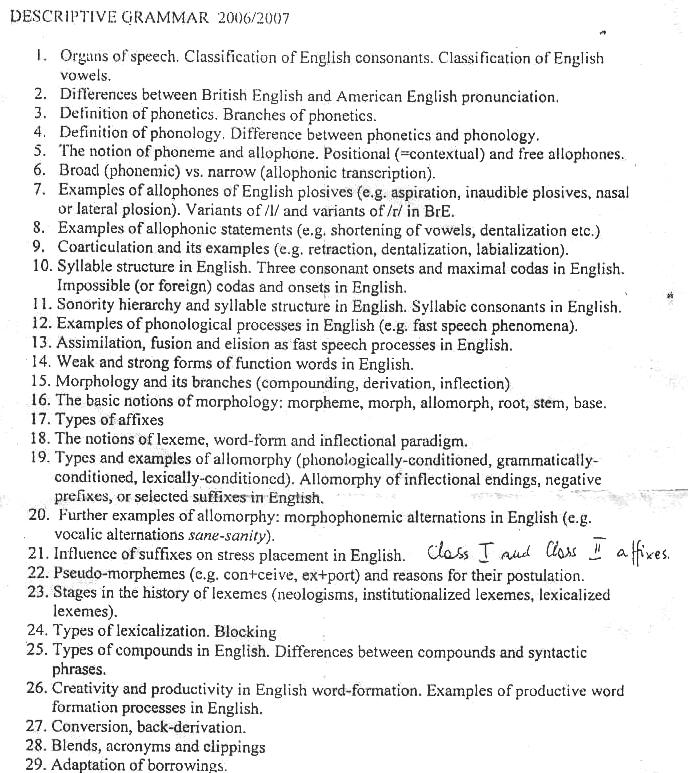deskriptiw

DESCRIPTIVE GRAMMAR 2006/2007
1. Orguns of speech. Classification of English consonants. Classification of English vowels.
2. Difterenees between British English and American English pronunciation.
3. Definition of phonetics. Branches of phonetics.
4. Definition of phonology. Differencc between phonetics and phonology.
5. The notion of phoncme and allophone. Positional (=contextual) and free allophones.
6. Broacl (phoncmic) vs. narrow (allophonic transcription).
7. Examples of allophones of English plosives (e.g. aspiration, inaudible plosives, nasal or lateral plosion). Variants of /!/ and variants of /r/ in BrE.
8. Examples of allophonic statements (e.g. shortening of vowels, dentalization etc.)
9. Coarticulation and its examples (e.g. retraction, dentalization, labialization).
10. Syllable structure in English. Three consonant onsets and maximal codas in English. Impossible (or foreign) codas and onsets in English.
11. Sonority hierarchy and syllable structure in English. Syllabic consonants in English.
12. Examples of phonological processes in English (e.g. fast speech phenomena).
13. Assimilation, fusion and elision as fast speech processes in English.
14. Weak and strong forms of function words in English.
15. Morphology and its branches (compounding, derivation, inflection)
16. The basie notions of morphology: morpheme, morph, allomorph, root, stem, base.
17. Types of affixes
18. The notions of lexeme, word-form and inflectional paradigm.
19. Types and examples of allomorphy (phonologieally-conditioned, grammatically-conditioned, lexically-conditioncd). Allomorphy of inflectional endings, negative prefixes, or selected suffixes in English.
20. Further examples of allomorphy: morphophonemic altemations in English (e.g.
łf*
vocalic altemations sane-sanity). —
21. Influence ofsuffixes on stress placemcnt in English. CuL^s T J!
22. Pseudo-morphemcs (e.g. con+ceive, ex+port) and reasons for their postulation.
23. Stages in the history of lexemcs (neologisms, institutionalized lexemcs, lcxicalized lexemes).
24. Types of lcxicalization. Blocking
25. Types of compounds in English. Differences between compounds and syntactic phrases.
26. Creativity and productivity in English word-formation. Examples of productive word formation processes in English.
27. Conversion, back-derivation.
28. Blends, acronyms and ciippings
29. Adaptation of borrowings.
Wyszukiwarka
Podobne podstrony:
SYLLABUS DESCRIPTION Course title: descriptive grammar Course codę: Type of course:
Part I: 1. ECTS system - introduction In 2006/2007 Lodź Academy of International Studies introduces
00360 Zf345dd7a4cd0dcee5807a96535464f 364 Obenchain Introduction We describe ways to use cost-of-po
img242 2 2006/2007 Dorota Tatrzauska-Kmiecik Rzeźbotwórcza działalność rzek. 1.
Slajd13 (33) ROZWÓJ REGIONALNY I LOKALNY W POLSCE W.DZIEMIANOWICZ, TEORIE I INSTRUMENTY...., 2006/20
Marek Kowalczyk Instytut Psychologii UAMMATERIAŁY DO WYKŁADÓW Z PSYCHOLOGII POZNAWCZEJ 2006/2007 TEO
PROGRAM NAUCZANIA rok akademicki: 2006/2007 Nazwa przedmiotu: Chirurgia i pielęgniarstwo chirurgiczn
PROGRAM NAUCZANIA rok akademicki : 2006/2007 Nazwa przedmiotu: Chirurgia i pielęgniarstwo
Section 1: Describe the need and role of addressing in a network (5 ąuestions) 148
więcej podobnych podstron